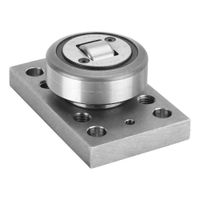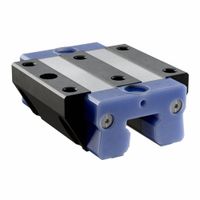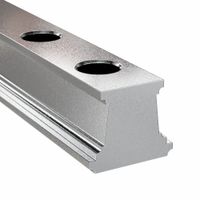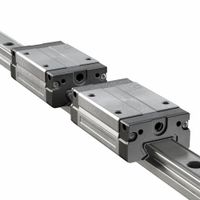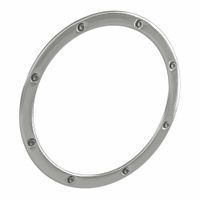Call +(254) 703 030 000 / 751 483 999 / 721 704 777
- Home
- Power Transmission
- Linear Motion
- Linear Guide Systems Components
.....Read More
Frequently Asked Questions
What are the different types of linear guide systems?
Linear guide systems are essential components in machinery that require precise linear motion. The main types include:
1. **Ball Bearing Guides**: These use recirculating ball bearings within a rail and carriage system, offering high precision and low friction. They are suitable for applications requiring smooth motion and high load capacity.
2. **Roller Bearing Guides**: Similar to ball bearings but use cylindrical rollers, providing greater contact area and higher load capacity. They are ideal for heavy-duty applications and environments with high vibration.
3. **Plain Bearing Guides**: Also known as bushings, these guides use sliding contact surfaces without rolling elements. They are simple, cost-effective, and suitable for applications with lower precision requirements or where contamination is a concern.
4. **Profile Rail Guides**: These are characterized by their high rigidity and precision, using either ball or roller bearings. They are commonly used in CNC machines and other precision equipment.
5. **Cam Roller Guides**: These use cam followers running on a rail, offering smooth motion and high speed. They are often used in applications requiring high acceleration and deceleration.
6. **Magnetic Guides**: Utilizing magnetic levitation, these guides eliminate mechanical contact, reducing wear and maintenance. They are used in specialized applications requiring ultra-smooth motion.
7. **Air Bearing Guides**: These use a thin film of air to support the load, providing frictionless motion. They are ideal for applications requiring extreme precision and cleanliness, such as semiconductor manufacturing.
8. **Linear Motor Guides**: Integrating a linear motor for direct drive, these guides offer high speed and acceleration with precise control. They are used in high-performance applications like robotics.
Each type of linear guide system has its own advantages and is chosen based on factors like load capacity, precision, speed, and environmental conditions.
How do I choose the right linear guide for my application?
To choose the right linear guide for your application, consider the following factors:
1. **Load Capacity**: Determine the maximum load the guide will need to support, including static and dynamic loads. Choose a guide that can handle these loads with a safety margin.
2. **Precision and Accuracy**: Assess the level of precision required for your application. High-precision guides are necessary for applications like CNC machines, while less precision may suffice for simpler tasks.
3. **Speed and Acceleration**: Evaluate the speed and acceleration requirements. Some guides are designed for high-speed applications, while others are better suited for slower movements.
4. **Environment**: Consider the operating environment. For harsh conditions (e.g., dust, moisture, chemicals), select guides with appropriate seals or corrosion-resistant materials.
5. **Size and Space Constraints**: Ensure the guide fits within the available space and meets the application's size requirements. Compact designs may be necessary for tight spaces.
6. **Mounting and Installation**: Check the ease of installation and compatibility with existing systems. Some guides offer flexible mounting options.
7. **Life Expectancy and Maintenance**: Consider the expected lifespan and maintenance needs. Longer-lasting guides with minimal maintenance can reduce downtime and costs.
8. **Cost**: Balance the cost with performance requirements. Higher-end guides offer better performance but at a higher price.
9. **Supplier Support and Availability**: Choose a reputable supplier with good support and readily available parts to ensure quick replacements and assistance.
10. **Application-Specific Requirements**: Address any unique needs, such as vacuum compatibility or cleanroom suitability.
By evaluating these factors, you can select a linear guide that meets your application's specific needs, ensuring optimal performance and longevity.
What are the benefits of using linear guide systems in industrial automation?
Linear guide systems offer several benefits in industrial automation:
1. **Precision and Accuracy**: Linear guides provide high precision and accuracy in movement, essential for tasks requiring exact positioning and repeatability.
2. **Load Capacity**: They can support heavy loads while maintaining smooth motion, making them suitable for various industrial applications.
3. **Reduced Friction**: The design minimizes friction between moving parts, leading to smoother operation and less wear and tear, which extends the system's lifespan.
4. **High Speed and Efficiency**: Linear guides enable high-speed operations with minimal resistance, improving overall efficiency and productivity in automated processes.
5. **Stability and Rigidity**: They offer excellent stability and rigidity, which is crucial for maintaining performance under dynamic loads and vibrations.
6. **Versatility**: Available in various sizes and configurations, linear guides can be customized to fit specific application needs, from small-scale precision tasks to large industrial machinery.
7. **Low Maintenance**: Due to their robust design and reduced friction, linear guides require less maintenance, reducing downtime and operational costs.
8. **Energy Efficiency**: The low friction and efficient movement reduce energy consumption, contributing to more sustainable operations.
9. **Easy Integration**: Linear guide systems can be easily integrated into existing automation setups, providing flexibility in design and implementation.
10. **Improved Safety**: By ensuring precise and controlled movements, linear guides enhance the safety of automated systems, reducing the risk of accidents and equipment damage.
These benefits make linear guide systems a critical component in enhancing the performance, reliability, and efficiency of industrial automation processes.
How do I maintain and lubricate linear guide systems?
To maintain and lubricate linear guide systems, follow these steps:
1. **Regular Inspection**: Frequently check for signs of wear, contamination, or damage. Look for unusual noises or vibrations during operation.
2. **Cleaning**: Keep the guides clean by removing dust, debris, and old lubricant. Use a lint-free cloth and a suitable solvent if necessary. Avoid using compressed air as it can push contaminants deeper into the system.
3. **Lubrication**: Use the manufacturer-recommended lubricant. Apply it evenly along the guide rails and into the ball or roller bearings. Ensure the lubricant is compatible with the materials and operating conditions.
4. **Lubrication Frequency**: Follow the manufacturer's guidelines for lubrication intervals. This can vary based on the operating environment, load, and speed. In harsh environments, more frequent lubrication may be necessary.
5. **Lubrication Methods**: Use manual application for small systems or automatic lubrication systems for larger or hard-to-reach setups. Ensure the lubricant reaches all critical points.
6. **Check Alignment**: Regularly verify the alignment of the guide rails. Misalignment can cause uneven wear and reduce system efficiency.
7. **Monitor Load and Speed**: Ensure the system is not overloaded and operates within the specified speed limits. Excessive load or speed can increase wear and reduce the lifespan of the guides.
8. **Replace Worn Components**: Promptly replace any worn or damaged parts to prevent further damage to the system.
9. **Environmental Control**: Protect the system from extreme temperatures, moisture, and corrosive substances. Use protective covers or seals if necessary.
10. **Documentation**: Keep a maintenance log detailing inspections, cleaning, lubrication, and any replacements or adjustments made. This helps in tracking the system's condition and planning future maintenance.
What factors affect the load capacity of linear guide systems?
The load capacity of linear guide systems is influenced by several factors:
1. **Material and Design**: The materials used in the construction of the guide rails and bearings, such as steel or aluminum, affect their strength and durability. The design, including the shape and size of the guide, also plays a crucial role in determining load capacity.
2. **Bearing Type**: Different types of bearings, such as ball bearings, roller bearings, or plain bearings, have varying load capacities. Roller bearings typically support higher loads compared to ball bearings due to their larger contact area.
3. **Preload**: Preloading involves applying a force to the bearings to eliminate internal clearance. This increases rigidity and load capacity but can also lead to higher friction and wear if not properly managed.
4. **Mounting and Alignment**: Proper mounting and alignment are critical. Misalignment can lead to uneven load distribution, increasing wear and reducing load capacity. The mounting surface should be flat and rigid to support the guide system effectively.
5. **Lubrication**: Adequate lubrication reduces friction and wear, enhancing the load capacity and lifespan of the guide system. The type and frequency of lubrication depend on the operating environment and load conditions.
6. **Operating Environment**: Environmental factors such as temperature, humidity, and exposure to contaminants can affect the material properties and lubrication, impacting load capacity. Special coatings or seals may be required for harsh environments.
7. **Dynamic vs. Static Loads**: The system's ability to handle dynamic (moving) loads versus static (stationary) loads can differ. Dynamic loads often require more robust systems due to the additional forces involved during motion.
8. **Speed and Acceleration**: Higher speeds and accelerations can increase the forces on the guide system, affecting its load capacity. Systems designed for high-speed applications often require specialized components to handle these conditions.
9. **Service Life Requirements**: The expected service life of the guide system influences the choice of materials and design, as systems designed for longer life typically have higher load capacities to accommodate wear over time.
How do I install linear guide rails and carriages?
1. **Preparation**: Ensure you have the correct linear guide rails and carriages for your application. Gather necessary tools such as a drill, screws, a level, a measuring tape, and a torque wrench.
2. **Workspace Setup**: Clean the installation area to remove any debris or dust. Ensure the mounting surface is flat and stable.
3. **Positioning**: Mark the positions where the rails will be installed. Use a measuring tape and a level to ensure accuracy and alignment.
4. **Mounting Rails**:
- Align the rail with the marked positions.
- Drill holes into the mounting surface if necessary.
- Secure the rail using screws or bolts, ensuring they are tightened evenly. Use a torque wrench to apply the recommended torque settings.
5. **Alignment**:
- Use a straightedge or laser level to check the alignment of the rail.
- Adjust as necessary to ensure the rail is straight and level.
6. **Installing Carriages**:
- Slide the carriage onto the rail carefully. Ensure it moves smoothly without resistance.
- If the carriage has a preload adjustment, set it according to the manufacturer's specifications.
7. **Testing**:
- Move the carriage along the rail to ensure smooth operation.
- Check for any misalignment or binding and adjust if necessary.
8. **Final Checks**:
- Recheck all screws and bolts for tightness.
- Ensure the entire assembly is secure and operates smoothly.
9. **Maintenance**: Regularly inspect the rails and carriages for wear and lubricate them as per the manufacturer's guidelines to ensure longevity and optimal performance.
What are the common issues and troubleshooting tips for linear guide systems?
Common issues with linear guide systems include misalignment, contamination, lubrication failure, wear and tear, and excessive load.
1. **Misalignment**: Misalignment can cause uneven load distribution, leading to premature wear. Ensure proper installation and alignment using precision tools. Regularly check alignment and adjust as necessary.
2. **Contamination**: Dust, dirt, and debris can enter the system, causing blockages and increased friction. Use protective covers or seals to prevent contamination. Regularly clean the guides and surrounding areas.
3. **Lubrication Failure**: Insufficient or improper lubrication can lead to increased friction and wear. Use the correct type and amount of lubricant as specified by the manufacturer. Establish a regular lubrication schedule and monitor for signs of lubricant degradation.
4. **Wear and Tear**: Over time, components can wear out due to friction and load. Regularly inspect the system for signs of wear, such as unusual noises or vibrations. Replace worn components promptly to prevent further damage.
5. **Excessive Load**: Overloading can cause deformation and failure of the guide system. Ensure the load does not exceed the system's rated capacity. If necessary, upgrade to a system with a higher load capacity.
Troubleshooting tips include:
- **Visual Inspection**: Regularly inspect the system for visible signs of damage or misalignment.
- **Noise Monitoring**: Listen for unusual noises, which can indicate misalignment or wear.
- **Vibration Analysis**: Use vibration analysis tools to detect imbalances or misalignments.
- **Load Testing**: Periodically test the system under load to ensure it operates within specifications.
- **Documentation Review**: Keep detailed records of maintenance and performance to identify patterns or recurring issues.
By addressing these common issues and following these troubleshooting tips, the longevity and performance of linear guide systems can be significantly improved.
